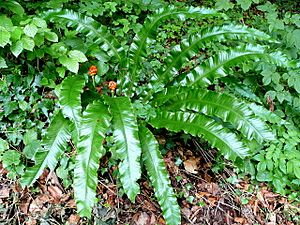Stenders Quarry facts for kids
| Site of Special Scientific Interest | |

Example - hart's-tongue fern growing in the Forest of Dean
|
|
| Area of Search | Gloucestershire |
|---|---|
| Coordinates | 51°51′46″N 2°29′45″W / 51.86269°N 2.49587°W |
| Interest | Biological/Geological |
| Area | 2.8 ha (6.9 acres) |
| Notification | 1966 |
Stenders Quarry is a special place in the Forest of Dean, Gloucestershire, England. It covers about 2.8 hectares (that's roughly the size of four football fields!). This area is known as a Site of Special Scientific Interest (SSSI). It was first recognized as important in 1966 and again in 1990.
Stenders Quarry is special because of its amazing rocks and fossils. It also has many different kinds of plants and animals living there. The site is also listed as a 'Key Wildlife Site' (KWS) in the Forest of Dean.
You can find Stenders Quarry west of Mitcheldean, next to the Drybrook road. It used to be called the Wilderness Cement Work Quarry. In the late 1800s, this quarry provided materials for a cement factory. Another nearby quarry, Scully Grove Quarry SSSI, also supplied the factory. You can still see parts of an old overhead tramway. This tramway was built to carry limestone across the road. The quarry stopped working in 1918 and was left empty. Today, students often visit to study the rocks.
The Gloucestershire Wildlife Trust owns and looks after Stenders Quarry. They bought it in 1974 to protect its natural features.
Contents
Exploring Stenders Quarry: Rocks and Fossils
The quarry has very steep slopes, showing many different types of rocks. You can see layers of limestone and shales from the Lower Carboniferous period. This was a time long ago when Earth looked very different.
You can also see where these rocks meet older rocks, like the Old Red Sandstone. The rocks here are full of fossils. These are the preserved remains of ancient life. You might find fossils of sea lilies, tiny water fleas, and different kinds of shellfish. These fossils tell us about the creatures that lived here millions of years ago.
Plants and Trees: A Green Wonderland
The thin soils over the limestone are perfect for many different plants. You can find colorful wildflowers like kidney vetch and cowslip. Look out for yellow-wort and ploughman's-spikenard. There are also large thyme, blue fleabane, and the beautiful common spotted-orchid. In late summer, the rare autumn gentian blooms.
Among the rocks, you'll see various ferns. These include black spleenwort, wall-rue, and hart's-tongue. Other ferns like lady-fern and polypody grow all over the reserve. The site also has many types of mosses and liverworts.
Part of the quarry is covered by trees and shrubs. You can spot wild cherry and pedunculate oak. There are also ash trees, dogwood, and hawthorn. Look for grey willow and dog-rose too.
Wildlife at the Quarry: Birds and Butterflies
Stenders Quarry is a great place for wildlife. You might see Great spotted woodpeckers tapping on trees. Tiny goldcrests, Europe's smallest birds, also live here. Many other birds that like bushy areas can be found too.
The quarry is a warm and sunny spot, which is perfect for butterflies. You can often see grassland butterflies like the marbled white. The site is also home to many different kinds of snails.
Protecting Stenders Quarry: Conservation Efforts
To keep the grassy areas and exposed rocks healthy, the Gloucestershire Wildlife Trust regularly clears away overgrown bushes. This helps the special plants and animals continue to thrive. It ensures that the quarry remains a valuable place for both nature and learning.

